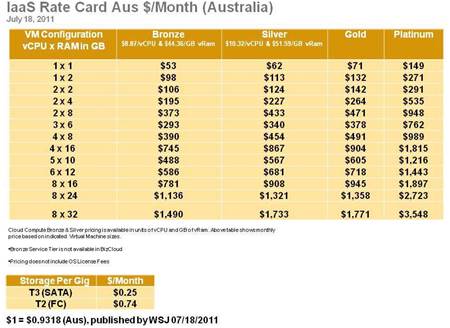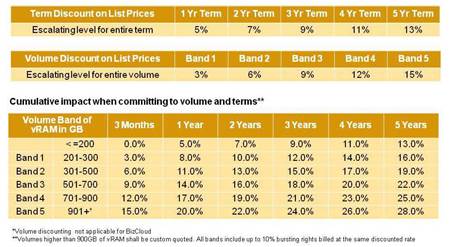CSC Australia has launched a third cloud computing option for those organisations that wish to embrace computing as-a-service without the risks of external hosting.
The so-called 'BizCloud' offering was designed to complement CSC’s public and dedicated cloud compute services hosted in the service provider's data centres in Sydney and Melbourne.
BizCloud sees CSC set up a complete cloud stack based on hardware and software from the Cisco/VMware/EMC alliance (a vBlock) inside a customer’s data centre.
But rather than a straight out system sale or outsourcing play, CSC maintains ownership of the infrastructure and the customer is charged for compute consumption per month.
Customers are required to pay for at least 33 percent of the vBlock’s capacity, measured as an average amount of vRAM used each month.
Beyond this commitment, the customer pays published monthly rates depending on the size of the compute instance and the level of support CSC is asked to provide (silver, gold and platinum – the latter including active-active synchronous replication).

The customer can also apply for discounts to the published rates by signing on for between one and five years of the service, or committing to higher volumes of capacity (again, measured in vRAM GBs).
At best, a customer committing to five years and over 900GB of vRAM could gain a 28 percent discount off the price list. CSC stipulates that the stack never runs at over 70 percent utilisation to ensure it can meet service level agreements.

The service is targeted at the enterprise market – with customers asked to forecast vRAM capacity in blocks of 96 GB.
Customers can measure their current utilisation rates, choose a vBlock that is three times larger, and only pay for what they use if their computing needs burst or grow over time.
Siki Giunta, vice president of global cloud services and software at CSC visited executives at Australian customers last week to explain the model.
The largest vBlock available, she noted, would cost about $6 million to buy upfront. For comparison, leasing of 33 percent of the capacity of the same stack would cost between $750,000 and $900,000 per year.
The first year would involve a managed service component under which CSC would “onboard” the stack and train an organisation’s staff to build a service catalogue/portal and develop chargeback processes in order to become an internal cloud service provider. This might cost in the order of $200,000 to $250,000.
So for the first year, CSC’s new cloud option might cost little over $1.1 million. Assuming utilisation rates remained static, the ongoing costs for future years would be under $1 million a year. These costs are split between hardware (40 percent), software (such as vCloud director and Cisco’s newScale service catalogue) at 30 percent and labour (30 percent), Giunta said.
So over a three-year lifecycle, the organisation might either save a considerable amount of cash if utilisation rates remained static, or pay more or less the same as buying the gear upfront should demand for compute capacity skyrocket – the only benefit being that CapEx costs are converted into OpEx costs.
While the model represented an insurance policy of sorts for organisations unsure about future growth, it would not insure against software licensing cost changes, or take into account any financial benefit an organisation might attain from depreciating IT assets over time.
Guinta argued that the cloud model encouraged the service provider to refresh infrastructure at a faster rate than traditional outsourcing deals.
“It creates a good dynamic – we would more likely refresh every 24 months to maintain scalability and meet SLAs. We are already up to the second generation of vBlock and [Cisco Systems’] Nexus line has been upgraded twice.”
CSC said it could have a large vBlock up and running within ten weeks after securing four-week turnarounds on hardware from the VCE alliance (VMware, Cisco and EMC).
The real savings would come from having a ‘private cloud’ effectively handed to the customer on a platter, with all the required software set up.
CSC also planned to introduce a series of vertical stacks that can be delivered as a service – such as a private healthcare cloud set up on vBlock with CSC’s healthcare software pre-installed and ready for deployment of patient records.






.jpg&h=142&w=230&c=1&s=1)
.png&h=142&w=230&c=1&s=1)




.jpg&w=100&c=1&s=0)
_(8).jpg&w=100&c=1&s=0)









